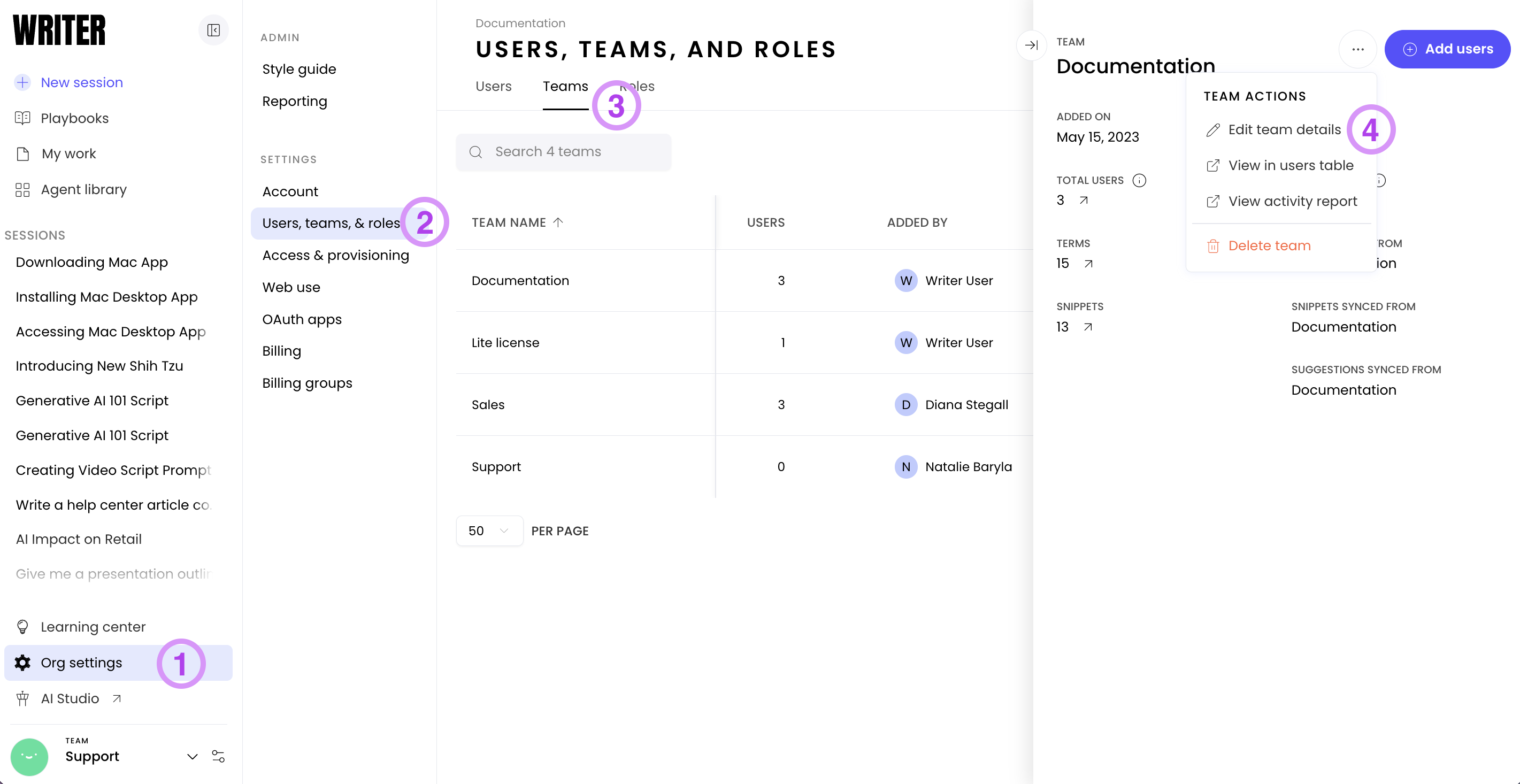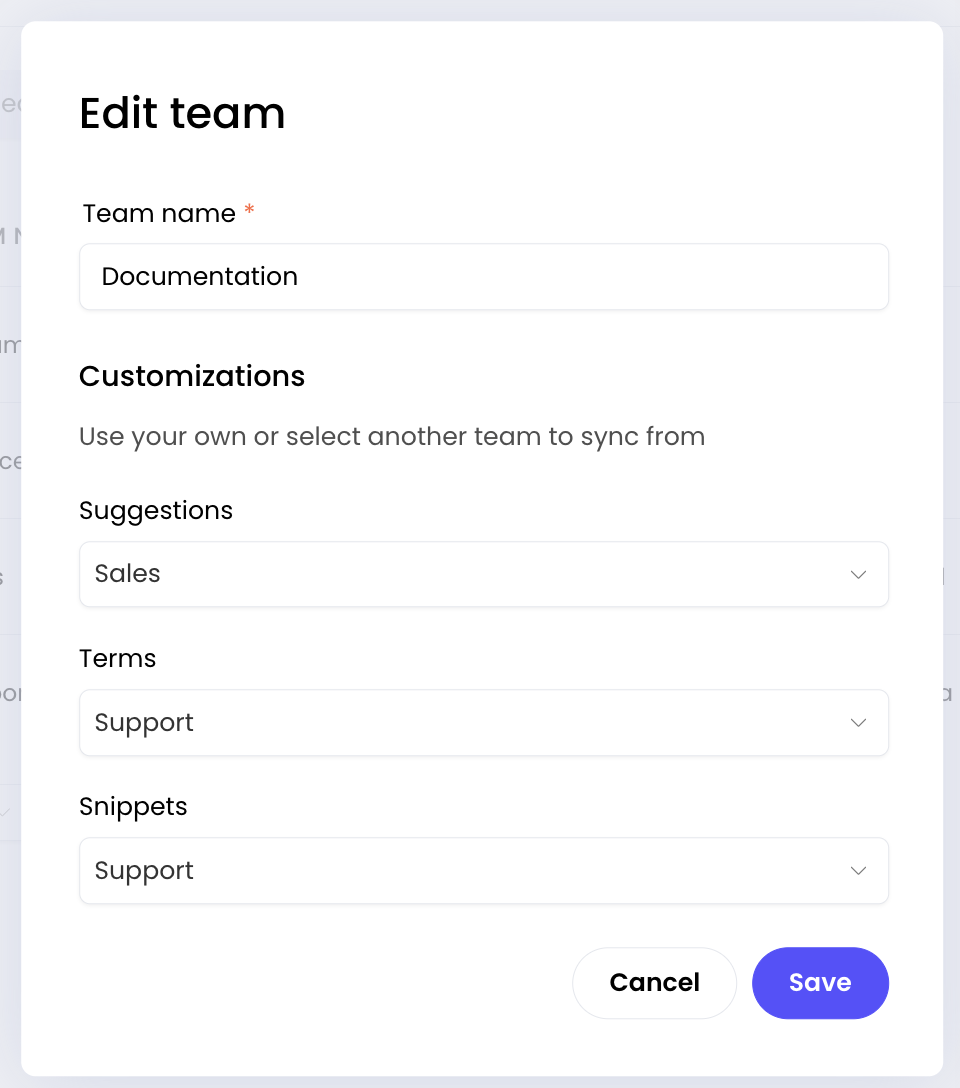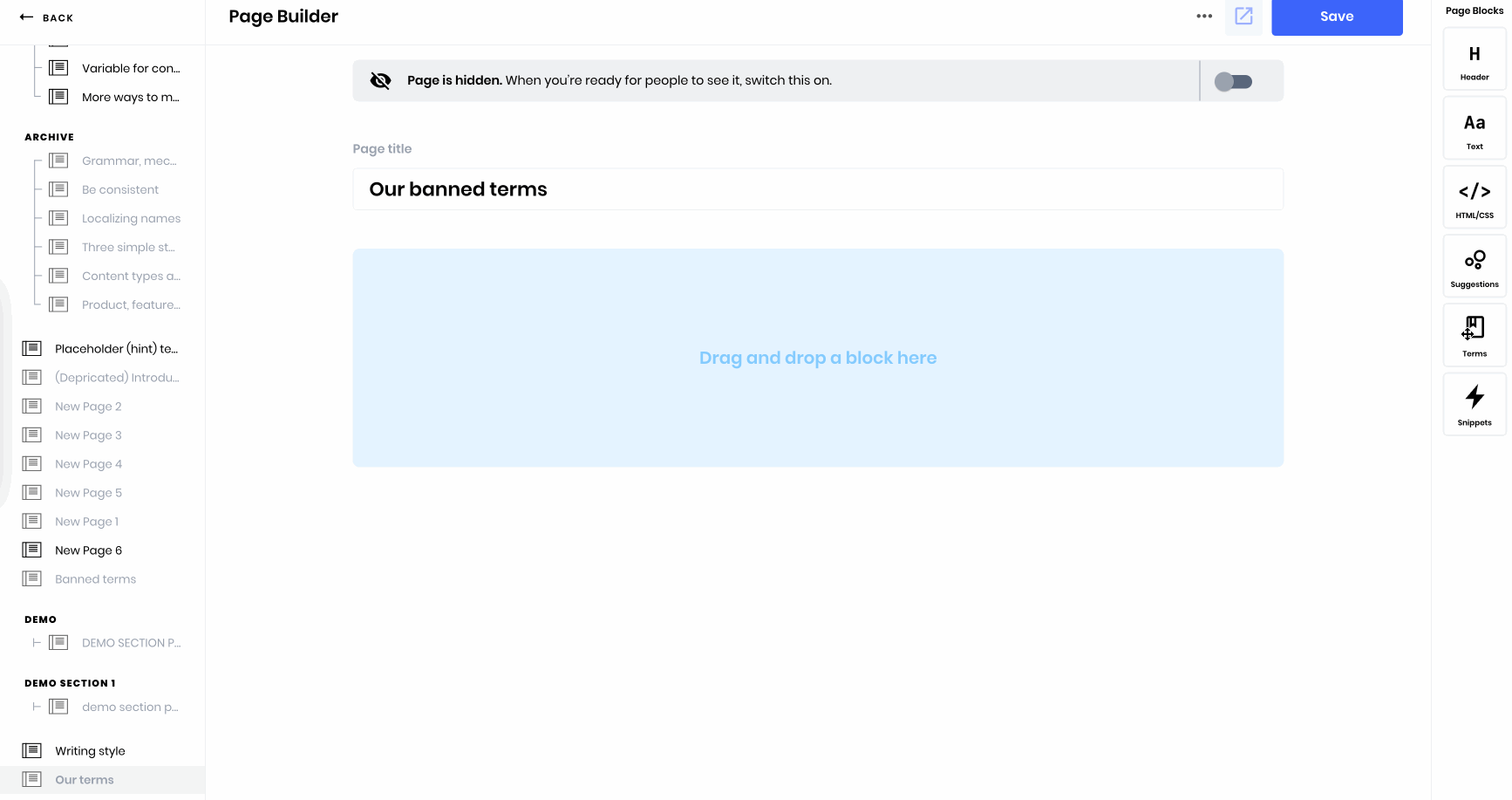Adding terms
Who can use this feature
- Supported on Starter, Teamand Enterprise plans
- Org admins, business admins, and team admins can edit terms.Team members can only view terms.
In this article:
- What are terms?
- Using terms
- Best practices
- Advanced options
- Managing, organizing, and downloading terms
- Using terms across multiple teams
- Adding terms to your style guide
- Importing terms
- FAQs
What are terms?
With terms, you can manage, enforce, and share terminology that’s specific to your company. You can use terms to:
- Flag when a teammate has misspelled your company’s name or used the wrong verb for a call-to-action, and automatically suggest a replacement
- Flag banned words and phrases — e.g., deprecated products, outdated wording, non-inclusive language
- Highlight words that need to be used cautiously and give your teammates specific context on how to handle
- Create a shareable glossary that your whole team can access, not just those with WRITER seats
Types of terms
You can create four types of terms in WRITER: Approved, Don’t use, Use carefully, and Pending.
✅ Approved terms (and their common mistakes): terms that are ok to use — they're part of your taxonomy (e.g., what you call a feature or service in your product) or word list (words you prefer writing a certain way, like Internet or email).
For each Approved term, you can add common mistakes. Common mistakes are ways that writers tend to write the term incorrectly.
❌ Don’t use terms: terms that your writers shouldn't use. These might be words that you've banned for compliance reasons, or because they're deprecated or extremely sensitive. You can link a Don’t use term to an Approved term that your team should use instead.
⚠️ Use carefully terms: terms that you can use in certain, specific contexts. We'll flag any use of this term so you can double-check to see whether you're using it appropriately.
❔ Pending terms: terms that are waiting for sign-off from your team before they can officially be labeled as Approved, Don’t use or Use carefully.
Using terms
How does WRITER enforce terms for your team? Check out below to see what happens when you’re writing in the Editor or with a WRITER extension enabled.
If we find an Approved term…
WRITER will highlight the Approved term in light blue. You can hover over an Approved term to see the full description.

If we find a Common Mistake…
WRITER will underline Common Mistakes in yellow. You can hover over the mistake to see the suggested replacement. Just select the suggestion in green to replace your mistake with the Approved term.

If we find a Don’t use term…
WRITER will underline the Don’t use term in yellow. You can hover over the underline to see more details. If the term has an Approved term alternative, we’ll suggest that as a replacement. Select the suggestion in green to replace your Don't use term.

If we find a Use carefully term...
Similar to a Don't use term, we'll always flag a Use carefully term. Flagging the term will encourage your team to double-check whether they're using the term under the right circumstances.

If we find a Pending term...
Since Pending terms are still awaiting approval by your internal team, WRITER won’t check for them in your content.
Customizing terms suggestion cards
Sometimes, using a term correctly can be context-dependent. Team admins in WRITER can use Description and Examples to provide teammates with more context about using the term.

Best practices
If you aren't sure how to begin building out your term bank, here are three common use cases:
Product terms
- Product names are typically spelled in a unique way and are often case sensitive. Sharing approved spelling and formatting for your product terms makes it easy to keep everyone on brand.
- Add any deprecated product terms as Don't use terms, helping your team stay consistent over time. For example, WRITER generative AI features used to be called Magic Mode. We no longer use this term, and this is listed as a Don't use term in WRITER for us.
Brand agnosticism
Many organizations have standards around brand agnosticism. If that applies to your team, add common brands like PowerPoint and Zoom as Don't use terms right away.
Standardization
Some customers refer to their customer success team as the "CX Team" while others may say "Customer Support". Consistent terminology will prevent user confusion and misdirection.
Advanced options
Advanced options in terms let you get more specific about when WRITER should flag a term.
Part of speech
WRITER supports four parts of speech: noun, verb, adjective, and adverb. You can add a term more than once if they are different parts of speech.
A common example is the term “login.” You could write this as “login” when used as a noun, but you should write it as “log in” when used as a verb.

To set up WRITER to check for this, simply add “login” as an Approved term, and select noun. Then, add “login” as a Common Mistake and select verb.
With this all set up, WRITER will only flag “login” as a mistake when it’s used as verb.

Case sensitivity
Terms, including common mistakes, can be case sensitive or insensitive. If you select case sensitive, then WRITER will only flag a term if the exact casing matches. If the term is not case sensitive, we’ll flag no matter what casing we see in your content.

If a term is case sensitive, you’ll see two additional options:
- Capitalize at the start of a sentence (default = on)
- When switched on, we’ll suggest that you capitalize this term to follow the basic rule of capitalizing at the start of a sentence, even if it’s lowercase in your terms list
- When switched off, we won’t suggest you capitalize this term. Make sure you’ve turned this off for any brand names with a lowercase first letter (e.g. “mPharma is the leading digital pharmacy in Ghana...”)
- Automatically suggest correct capitalizations (default = on)
- When switched on, WRITER will suggest the correct capitalization to users who are using the wrong capitalization. e.g., if your term is “Acme Widget” and a user writes “Acme widget,” WRITER will suggest the correct capitalization even if you haven’t listed “Acme widget” as a common mistake.
Enable/disable suggestions
If you’re not ready to start enforcing a term with WRITER suggestions in your content, you can always disable this using the enable/disable suggestions toggle.

Managing, organizing, and downloading terms
Using tags
Tags are a great way to keep terms organized by use case, Team, or category.

When you’re ready to share and publish your terms, you can use tags to specify exactly which terms to publish.
Downloading terms
You can download terms by clicking the download icon in the terms toolbar. Your terms will be saved to your Downloads folder as a CSV file.

Using terms across multiple teams
Different teams can use the same term bank.

As an admin, access Org settings > Users, teams, & roles > Teams and then select Edit team details from the ••• menu.

Under Terms select the team with the term bank you'd like to use.
Adding terms to your style guide
Once your terms are in WRITER, it’s easy to build and publish a terms list in just a few clicks with our style guide feature. Style guides can be password-protected, but don’t require a WRITER seat to access them.
In your style guide Page Builder, select a terms page block. You can either publish all your terms, or you can select specific types or tags to publish.

Your published terms will look like this. You’ll be able to filter by term type or search for a specific term.

Importing terms
FAQs
Q: I have a term that isn’t quite Don’t use, but isn’t Approved either. How do I handle this?
We recommend using our Use carefully category for these words, then using the description to describe the correct context for using the term. We'll always flag this term for your team, to encourage them to double-check the context.
Q: Why isn’t my Approved term getting highlighted?
WRITER will only highlight Approved terms with a description filled in. We also don’t highlight Approved terms in our Word or Outlook add-ins.
Q: Can I add duplicate terms?
Yes, but they’ll need to be different parts of speech and have unique case sensitivity.
Q: What if I or someone on my team doesn’t want to see my Approved terms highlighted in blue?
You can turn this off for yourself in the Chrome extension menu.
Q: My terms download has weird symbols when I open it in Excel
If you’re seeing symbols like these {“} when you open your CSV in Excel, check that you are are opening the file with UTF-8 encoding. On MacOS, you can do this by going to Import File → Select UTF-8.